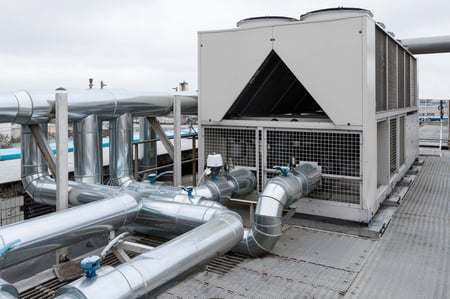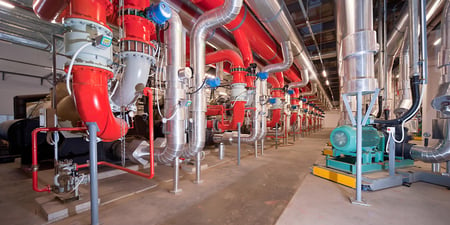Chiller System Design
Your chiller project will turn out as a definite success if you have a detailed design outlined early on. NYE can offer this crucial blueprint.
Our chiller projects are designed with maximum efficiency. We always go for cost-effective and low-maintenance results.
Our designs are done by engineers and designers who know how to make chiller outputs that stand the test of time, making it all worthwhile.

Chillers are an important component of any HVAC system, being a part of various facilities including restaurants, hotels, hospitals, manufacturing plants, and more. They’ve been widely used in a number of establishments, making them one of the largest electrical consumers with more than 50% of the entire electrical usage in the US during seasonal periods.
Statistics from the US Department of Energy revealed that all chillers throughout the country combined can use up to 20% of the entire electric power which is generated in North America. Such massive consumption can be caused by poorly performing chillers with inefficient designs.
We at NY Engineers aim to solve that problem by addressing cost-inefficiency and even outdated designs through our detailed and cost-effective chiller design solutions.
If you need a custom chiller design for your HVAC system, our professional and experienced team of designers and engineers can help you. With our custom chiller design solutions, you will be able to create a healthier indoor environment, cut down on energy consumption, and reduce your facility’s carbon footprint.
Our solid MEP engineering design expertise is what you need to turn your Chiller design project into a huge success. We can deliver designs in BIM format and create spatially coordinated 2D and 3D models that your contracting and installation teams can access. In every stage of the design process, we provide the best level of support we can render. We help you in every step of the way—from the concept, schematic, and design phase all the way to the construction stages.
Thinking of a chiller design can be challenging, especially if you don’t know where and how to start. That said, it certainly helps if you know what you should consider for the overall design of your chiller.
Here at NY Engineers, we always consider several factors in order to come up with a foolproof chiller design. Alternatively, if you already have a specific design in mind, we’ll help you review and visualize it through 3D modeling, so you’ll know what it looks like once it’s manufactured.
A chiller can come in several types (more details discussed further below). Depending on your preference, you can either have an air-cooled design if you have limited indoor space or a water-cooled design if you have a lot of space to spare indoors.
Chilled water systems will have delta Ts ranging from 10 to 16 degrees while supply temperatures normally range from 38 to 44 degrees Fahrenheit.
Higher delta Ts combined with lower supply temperatures will result in smaller coils at both terminal and air handling units; however, they will cause your chiller to consume a higher amount of energy.
Large systems will typically use a variable primary flow piping system due to their lower energy consumption and upfront cost. However, for modular chillers, a primary-secondary system is preferred since it is required to maintain minimum flow via the chiller during low load days. This is to prevent cycling the chiller because of low flow. On modular chillers with a constant load profile, a primary-secondary pumping system will be a good option.
Another vital component of an effective chiller design is the way the chiller will operate. That said, you need to determine when you want your chiller to operate. Do you need constant cooling inside your facility 24/7? Or do you prefer space cooling which will only operate during summer seasons? By providing us with such information, we’ll be able to come up with a design which can meet such conditions.
The standard pressure rating for a chiller is 125 PSI although you can have a chiller manufactured with a higher rating at additional costs. Facilities located inside a tall building higher than 280 feet can have issues with the pressure, especially if the chiller plant is at the bottom.
It will be our responsibilities as designers to look at locating the chiller plant to a central location or perhaps use heat exchangers for providing pressure breaks.

As mentioned earlier, chillers can be classified into several types. The type of chiller you preferred is essential, so we can come up with the right design that will cater to your needs. Primarily, chillers are categorized into two: air-cooled and water-cooled.
Air-cooled chillers look just like the radiators in cars which are used to cool their engines. They use a motorized blower to remove heat and force air across the tubes of the condenser. Compared to water-cooled variants, air-cooled systems require more energy although they’re an excellent option in terms of stationary cooling.
Since air-cooled chillers rely on a condenser which is being cooled by the surrounding air, they’re mostly found in smaller or medium installations with limited space. They’re also very easy to install and can even be installed outside without any extra space requirements.
Air-cooled chillers hold the advantage of having lower installation costs than water-cooled chillers. Additionally, they require less maintenance compared to their water-cooled counterparts. However, as they’re mostly installed outside, they will become more prone to recirculation, blockage, and other issues caused by outdoor elements.
Water-cooled chillers, on the other hand, have a water-cooled condenser which is connected with a cooling tower. Compared to air-cooled versions, they are more ideal for medium and large installations with a sufficient water supply. Additionally, they offer more constant performance for both industrial and commercial cooling.
As opposed to air-cooled chillers, water-cooled chillers are normally installed in an indoor environment, thereby protecting it from the outdoor elements. As a result, they can last way longer. However, since they will require a cooling water system, the installation expenses are way higher than air-cooled chillers. Routine maintenance is also necessary to keep them in good working condition at all times.
While chillers are categorized into two, air-cooled and water-cooled chillers can be further categorized based on the compressor technology they’re using. These are as follows:
Earlier, we mentioned that poorly designed chillers are among the biggest consumers of electricity throughout North America. However, apart from that, they’re also the reason why lots of buildings and facilities ended up losing billions of dollars every year.
With a well-designed chiller, however, you will be able to avoid such expenses. So why exactly does a chiller design matter?

Our team here at NY Engineers consist of passionate and skilled professionals who can create designs, come up with concepts, and visualize your chiller through 3D modeling and rendering.
To ensure a smooth and complete process, we normally follow these procedures:
Our 3D BIM design service makes sure that you can have a fully functional and highly efficient chiller design for your facility.
We at NY Engineers help construction firms transform projects into BIM environments while at the same time empower site managers for cost and risk reduction for their construction project’s entire cycle.
By working with us, you are guaranteed:
For all your BIM modeling and design needs, NY Engineers will be your best go-to team. Get in touch with us now so we can cater to your request immediately. We’ll also be glad to provide you with a FREE estimate.